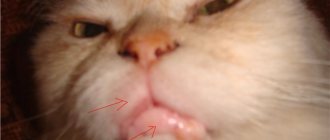Why are there allergies to cats?
An allergic reaction is a response of the human immune system to an external irritant. In the case of an allergy to a pet, the irritant is not the cat itself, but the proteins it secretes. They are found in saliva, urine, gland secretions, dandruff, and skin particles. And wherever the pet is, it leaves its “biological trace.”
Foreign protein appears on carpets, upholstered furniture, on the floor, in bed. But most of all, of course, it is on the cat’s fur. As soon as you pet or hug your pet, allergens are transferred to the skin and mucous membranes.
The immune system perceives foreign protein particles as a pathogen and begins to fight it. In children and allergy sufferers, the immune system is imperfect, so the reaction may be excessive, too pronounced. Characteristic symptoms develop that can persist for a very long time. While the body is in contact with the irritant, the allergic reaction cannot disappear.
“There are no cat breeds that are safe for allergy sufferers,” clarifies Anna Kapustina. “Allergies can be caused by all warm-blooded animals, not only fluffy cats, but even “hairless” sphinxes.”
Composition of cat food
What must be included
- Animal protein (at least 20–22%, ideally at least 35%): fresh or dried (dehydrated) poultry, beef, veal, rabbit, and in very rare cases, pork.
- By-products (at least 10%): liver, heart, etc. The exact ratio of by-products must be indicated on the packaging.
- Plant carbohydrates (minimal content): rice, barley, oats and legumes.
- Plant fiber (no more than 25%): herbs, vegetables, fruits. Carrots, zucchini, pumpkin, broccoli, asparagus, cucumbers, celery, beets, green beans, parsley, dill, lettuce, and sprouted grass are safe.
- Vitamins and minerals: taurine, vitamin B, E, unsaturated acids omega-3 and omega-6, calcium, potassium, amino acids.
- Rosemary extract as a natural preservative and antioxidant.
What should be the minimum
- Cereals and legumes: wheat, corn and soybeans. As a rule, they are used to “fill” inexpensive feeds, replacing them with other products in the premium segment.
- Synthetic preservatives E320 and E321, as well as flavoring additives.
Dry food for kittens, pregnant and lactating cats Winner “Chicken”, 190 g 75 rub.
Wet cat food Gourmet Mon Petit “With salmon in sauce”, 50 g x 30 pcs. 552 rub.
Dry food for kittens, grain-free Primordial “Duck/Turkey”, 400 g -14%
548 rub. 637 rub.
Dry food for adult sterilized cats Savarra Light Cat “Turkey-rice”, 400 g 414 rub.
Wet food for cats Mnyams “Juicy pieces with Farmer’s Fair chicken”, line “Fedor the Cat”, 85 g 38 rub.
Whiskas “Chicken Stew” wet cat food, 85 g x 28 pcs. 601 rub.
Whiskas wet cat food “Salmon Jelly”, 85 g x 28 pcs. 601 rub.
Felix wet cat food “Appetizing pieces with chicken in jelly”, 85 g x 24 pcs. 546 rub.
Food for your cats on TEA.ru
What is strictly forbidden
- The following vegetables: potatoes, eggplants, tomatoes, avocados, onions and garlic, rhubarb, sorrel (can cause severe poisoning). Grapes, raisins, and persimmons are also toxic to cats.
- Cocoa beans, cocoa, chocolate. They contain theobromine, which is incredibly beneficial for humans, but very dangerous for cats.
- Salt.
How does a cat allergy manifest?
The symptoms are similar to an allergic reaction to any other irritant. Itching in the nose, sneezing and coughing, and a feeling of swelling in the nasopharynx may occur. The mucous membrane of the eyes reacts to the allergen, swelling of the eyelids and redness develop, the eyes may itch and water. When a skin reaction occurs, itchy rashes and hives occur.
In children, the allergic reaction is often more severe than in adults. A long-term course has a negative impact on the functioning of the respiratory system and can result in serious complications. Over time, the cough becomes paroxysmal, with a characteristic whistle, and the attacks end with a spasm of the respiratory tract and the inability to take a deep breath. Allergies in a child cannot be ignored, as they can trigger the development of bronchial asthma.
The psychosomatics of allergies to cats does not differ from those to other allergens. Similar reactions can be caused by household dust and plant pollen that a pet brings from the street on its fur. Allergens can be found in cat food, grooming products, and even litter. Therefore, identifying the true cause of the reaction is extremely difficult.
What foods most often cause allergies?
Food allergies in cats most often occur due to feeding the following foods:
- dry food, which can be high-quality or cheap, a reaction is formed to the contained chemicals, dietary supplements or even vitamins;
- chicken, it is one of the most easily digestible foods, is deposited in many tissues, and can cause inflammation of the joints;
- Dairy products in cats, just like in humans, cause an increased reaction of the immune system;
- canned additives that allow long-term storage of cat food in tin packages;
- vegetables, cereals, various types of meat.
Allergy in a cat
Attention! A cat's allergy to food most often manifests itself in skin reactions and affects the quality of the coat, but a systemic disorder can also occur.
What to do if you have a cat allergy
If you are just planning to get a pet, it is advisable to examine all family members for a tendency to an allergic reaction. The cat allergy test is worth taking for both children and adults, even those who are not prone to allergies and have never suffered from such reactions. According to allergist-immunologist Anna Kapustina, it is necessary to contact a specialist who will select the optimal examination method for the child and adult.
If the pet is already in the house and has caused an allergic reaction in one of the family members, experts recommend consulting a doctor as soon as possible to prevent complications from developing. It is important to understand that an allergy to cats does not go away; it is a specific reaction of the body, which can only be dealt with by limiting contact with the allergen and undergoing a course of drug therapy.
Treatment for cat allergies includes taking various antihistamines. If there is a profuse flow from the nose or congestion, specialists usually prescribe anti-inflammatory sprays containing corticosteroids. For skin rashes, the doctor may recommend ointments with anti-inflammatory, anti-edematous effects, and in case of problems with the respiratory system, inhalations that relieve spasms of the respiratory tract and make breathing easier.
Important! The treatment tactics should be selected by the doctor.
It is unacceptable to use anti-allergy drugs on your own, much less to treat a child. In addition, it is important to understand that therapy will only be effective if contact with the allergen is excluded. When the irritant remains in close proximity to the allergy sufferer, the allergy symptoms will only get worse.
Symptoms of food allergy in kittens and adult cats
Allergy to cats: how it manifests itself, symptoms in adults
Every owner should know how cats are allergic to food:
- itching, which causes the animal to scratch its back, paws, ears, belly, face;
- discharge from areas of the body where the mucous membrane occurs, for example, conjunctivitis and rhinitis may begin;
- allergic dermatitis;
- increased sweating, which is not normally typical for a cat - the armpits and groin area are constantly wet;
- loss of teeth and hair, which significantly worsens the well-being and appearance of the animal;
- swelling of the limbs, muzzle;
- swelling of internal organs, for example, the respiratory tract, which leads to shortness of breath, heavy breathing, and a prolonged cough.
Important! Owners often confuse allergies with intolerance to certain types of foods. In the latter case, dyspeptic reactions occur in the form of nausea, vomiting, and diarrhea.
Allergic conjunctivitis
How to get rid of cat allergies
“There is allergen-specific immunotherapy,” comments allergist-immunologist Anna Kapustina. — It involves the introduction of an allergen into the body in gradually increasing doses. Therapy helps reduce allergy symptoms or get rid of them completely. But in Russia, drugs for ASIT with cat allergens have not yet been registered.”
Therefore, allergists advise placing your pet in good hands. Unfortunately, there is no other way to get rid of an allergic reaction. If this is not possible, try to limit the contact of the allergic person with the pet as much as possible and follow these rules.
- Do not pick up the animal. Do not pet him, do not let him into the bedroom, and especially not on the bed.
- Use a humidifier. Allergens can remain suspended in the air for a long time. Air humidification causes microparticles to swell and increase in volume, causing them to fall to the floor or furniture.
- Do wet cleaning. As often as possible, at least three times a week. It is important to wipe with a damp cloth not only the floor, but also furniture, window sills, flower leaves, that is, all surfaces on which allergenic particles can linger.
- Review the furnishings of your apartment. Get rid of carpets where allergens linger for a long time and it is extremely difficult to remove them from the pile. Replace furniture with textile upholstery with armchairs and sofas with leather or leatherette covers that can be washed regularly. Remove curtains and floor lamps with fabric lampshades. The space should be such that any surface can be easily wiped with a damp cloth.
You need to wash your cat daily, just with water from the shower without shampoo. Water washes away allergenic particles from the fur and makes the pet safer for allergy sufferers. But even this procedure is dangerous if you are prone to allergies, so entrust the care of the animal to a family member who does not suffer from an allergic reaction.
What measures to take
Food allergies in cats do not require drug treatment. However, a lifelong diet is required, the main purpose of which is to eliminate the allergen from the animal’s food.
There is no vaccination. The vaccine is partially effective only for atopic dermatitis.
How to properly put a cat on a diet
A diet for food allergies is a complete change in the animal’s diet. It introduces only one source of protein, which has never been on the menu before. Other proteins are excluded completely. This diet is called exclusion or elimination. For example, the cat ate food based on chicken or fish. This means that the new food should not contain these protein sources, but should be made from beef or horse meat.
Before “treating” an allergy with an elimination diet, you need to:
- For 7-14 days, keep records of what food (products) the animal was fed, in what portions, and whether there were treats. Also record the nature of adverse reactions.
- Rule out fungal diseases, pyoderma, fleas.










